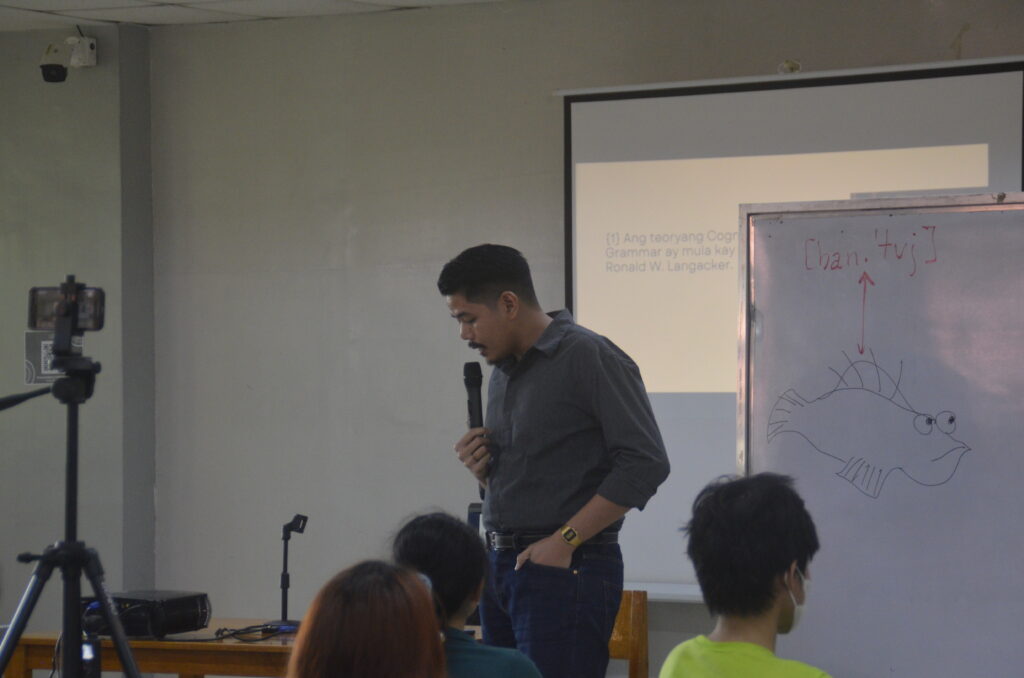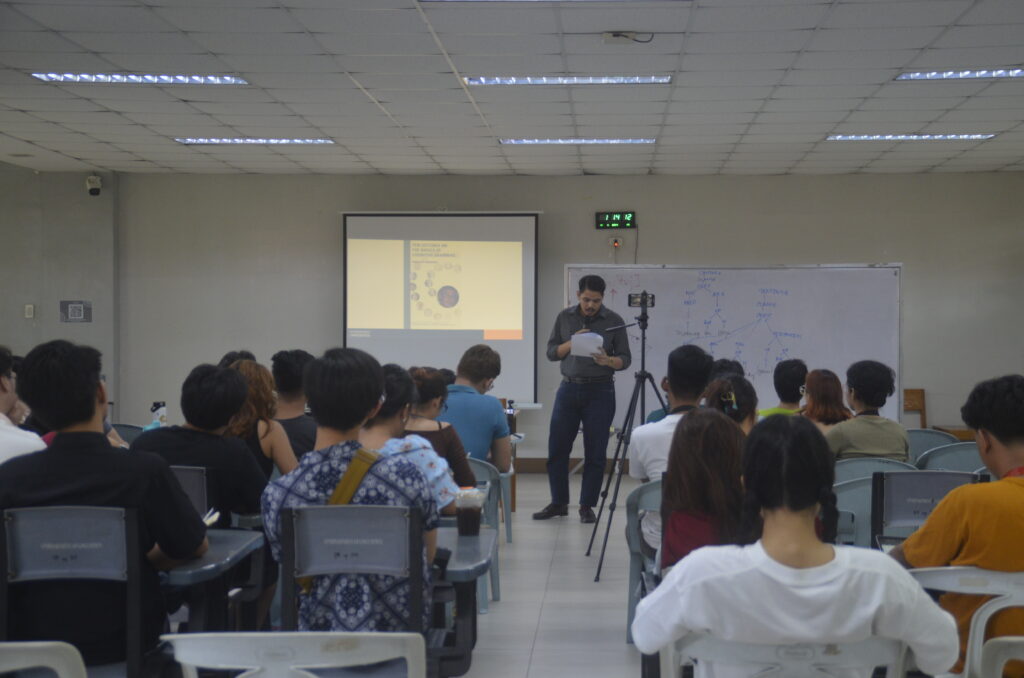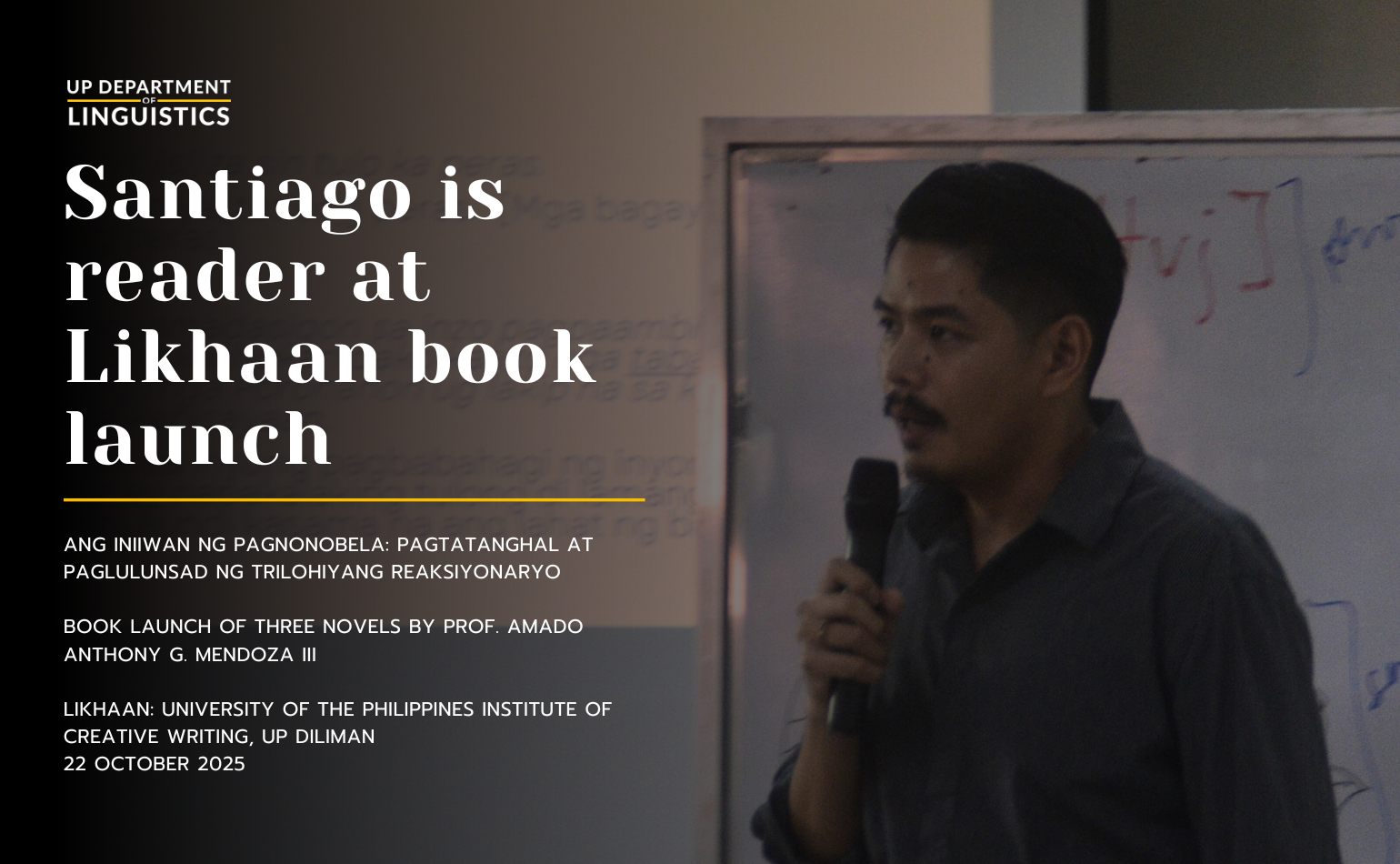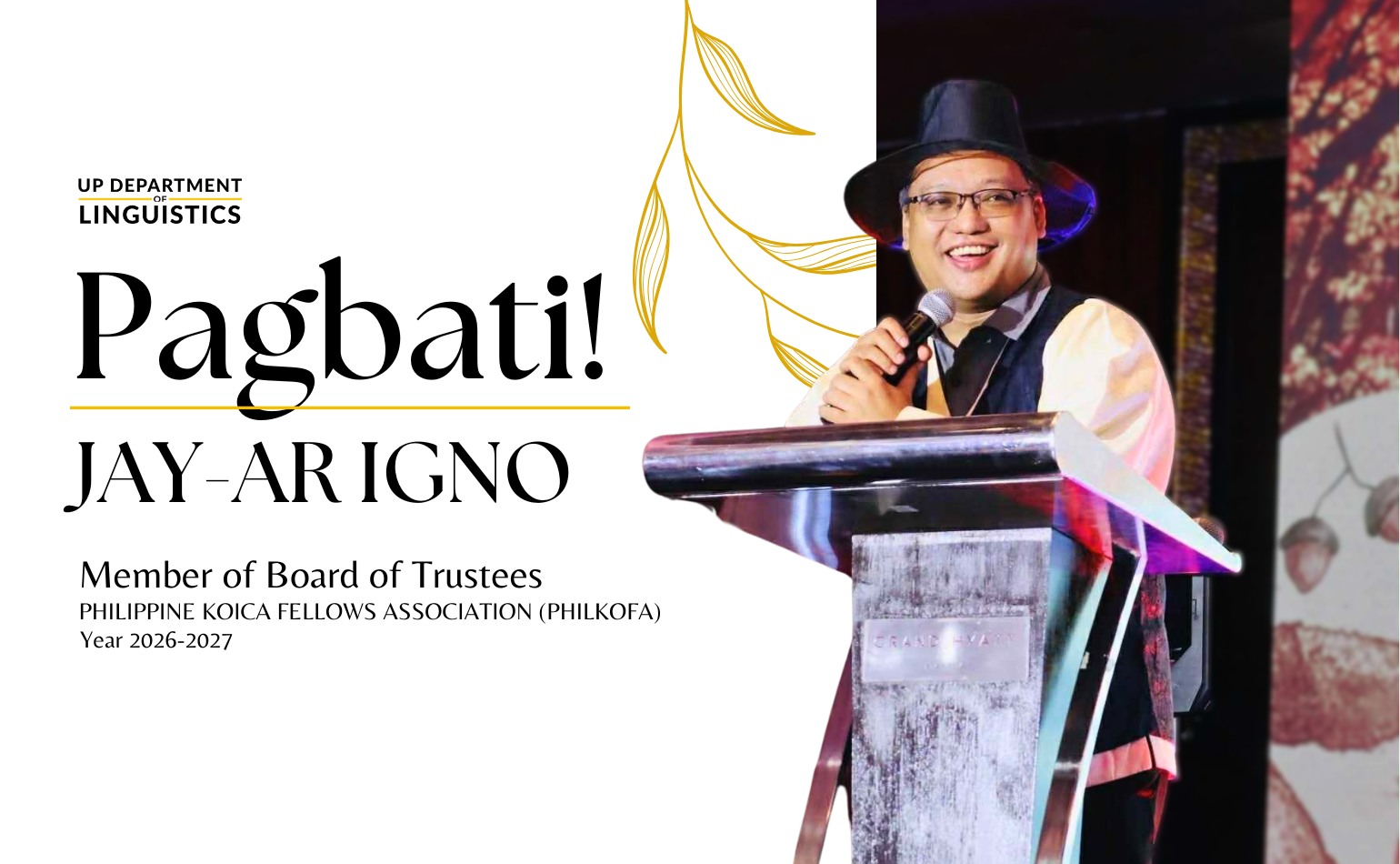
As part of the fifth installment of this year’s Philippine Indigenous Language Lecture Series (PILLS 2025), Asst. Prof. Vincent Christopher A. Santiago presents a brief overview of four contemporary grammatical theories and how each can be applied to a Philippine language. In particular, Asst. Prof. Santiago examines Porohanon (ISO 639-3 [prh]), a Bisayan language spoken in the Island of Poro within the Camotes group of Islands in the Province of Cebu. Asst. Prof. Santiago has previously engaged in fieldwork with the Porohanon language community and his fieldwork culminated in his Master’s Thesis, “A Grammatical Sketch of Porohanon.” His lecture is entitled “Tangkang Paglalapat ng Ilang Kontemporanyong Teoryang Panggramatika sa Porohanon” (An Application of Contemporary Grammatical Theories to Porohanon). The lecture is a combination of capsule lectures covering Ronald W. Langacker’s cognitive grammar theory, William Croft’s radical construction grammar (RCG) theory, Robert van Valin and William A. Foley’s role and reference grammar (RRG), and Joan Bresnan and Ronald M. Kaplan’s lexical-functional grammar (LFG). Asst. Prof. Santiago aims to show undergraduate and graduate students of the grammatical theory classes (Lingg 140: Introduksyon sa mga Gramatikal na Teorya and Lingg 206: Gramatikal na Analisis 1) that it is possible to apply the grammatical theories that they learned in class to Philippine languages—and that it has been done—and to underscore the uniqueness of Porohanon and its similarity to other Bisayan and Philippine languages. The in-person lecture was held last 20 May 2025 at the CSSP Health & Wellness Center located on the third floor of Palma Hall Pavillion One, but the lecture can also be viewed online on the Department’s Youtube channel.
Asst. Prof. Santiago begins his capsule lectures with a discussion on cognitive grammar. The theory was developed by Roland W. Langacker and much of the its tenets are covered in the first (1987) and second (1981) volumes of Langacker’s “Foundations of Cognitive Grammar” published by the Stanford University Press, though its beginnings lay earlier. The theory’s most recent developments are found in the “Ten Lectures on the Basics of Cognitive Grammar” (2017), a collection of Langacker’s lectures published by Brill. In the Philippines, one representative work focusing on the cognitive grammar perspective is Assoc. Prof. Jem R. Javier’s MA Thesis entitled “Ang Clause Structure ng Tagalog batay sa Cognitive Grammar” (The Clause Structure of Tagalog based on Cognitive Grammar) (2013). The cognitive linguistics enterprise from Langacker to all its other scholars emphasizes the integration of language with human thought, squarely placing grammatical theory within the realm of cognitive linguistics. Scholars of the enterprise have two commitments: the generalization and cognitive commitments. First, they commit to the sameness of structural principles across levels of grammar, levels which belong to a continuum within the human expressive capacity. Second, they commit to the integration of cognitive processes in language formation with other cognitive processes such as smells, colors, etc. As Asst. Prof. Santiago puts it, “iisa lang ang utak na gamit natin sa lahat ng bagay” (we use only one brain for everything). At the core of this framework is the basic unit of grammatical analysis, the “symbollic assembly” between the semantic pole involving meaning and the phonological pole involving external manifestations such as words, signs, etc.

In the cognitive grammar framework, the grammar of Porohanon is a “transduction device” that assembles the semantic and phonological poles together. Using the example of the stonefish (Synanceia verrucosa), known in Porohanon as the “bantuy,” cf., Cebuano “bantol,” Asst. Prof. Santiago illustrates the manifestation of the “symbollic assembly” in Porohanon. At the semantic pole, there is the description of the fish: “namamalagi sa batuhan sa katubigan ng Camotes” (residing in the rocky reefs of Camotes’ waters), “brawn na kulay” (colored brown), “maluwag na mata” (having spaced eyes), has spines, and as per one of his consultants, Sir Edwin Marquez, Porohanon fisherman also describe the “bantuy” as being territorial. At the other end, the phonological form “bantuy” in Porohanon contains the sounds [b], [ʌ], [n], [t], [ʊ], [j], which when strung together, is visualized by Porohanon speakers as a stonefish. To add, the “bantuy” is also culturally relevant. Porohanon kids tease those who stay motionless in a daze with “dagway nimo daw gikaw bantuy” (your face is like that of a stonefish’s). Using this example, Asst. Prof. Santiago underscores the productivity of cognitive grammar’s objective to view language as being integrated with the wider ability of humans to think and their relationship to the environment.
Moving into a similar grammatical theory, Asst. Prof. Santiago begins discussing radical construction grammar (RCG), a theory developed by William Croft and well represented in his works: “Radical Construction Grammarː Syntactic Theory in Typological Perspective” (2001) published by the Oxford University Press and “Morphosyntaxː Constructions of the World’s Languages” (2023) published by the Cambridge University Press. Quoting Anna Wierzbicka, Polish linguist and semanticist, Asst. Prof. Santiago even points out that both RCG and cognitive grammar belong to one functional-cognitive paradigm. Like cognitive grammar, RCG also has a continuum perspective going from more atomic to more complex constructions with the construction, an arbitrary form-meaning pairing, as the most basic unit of grammatical analysis. What makes RCG radical is the treatment of these constructions as being language specific. Constructions are labeled with the name of the language and an initial capital letter, e.g., Porohanon Common Noun, as opposed to more universal constructions which are labeled with small capital letters, e.g., common noun. The basis for identifying these construction types are their prototypical propositional acts of (1) reference or identifying a concept, entity, or object from human experience, (2) predication or connecting the referent with an act or event, and (3) modification or enriching the identity of a referent based on its features.

Each construction type according to RCG prototypically performs one of the prepositional acts but depending on the language, they may also perform non-prototypical acts. For example, in Porohanon there are the words “hatag” ‘to give’ and “tabang” ‘to help’ which are prototypically verbs and perform predicative acts as in “gipanghatag namon an daan nga sinina sa mga pobre” (we gave the old clothes to the poor) and “kay gitabangan lagi siza nga ibalik an kalo” (because they were assisted in returning the hat). However, these verbs also perform non-prototypical verb acts like referential acts as in “an gihatag lat za sin tulo ka peras” (what was given to him were three pears) and “[…] dako kaazo nga tabang […]” (a great help). Though it is commonly claimed that there are no lexical categories, e.g., verbs, nouns, etc., in Philippine languages, the RCG framework makes it clear that while there are verbs, they can also perform non-prototypical functions. Asst. Prof. Santiago even muses, “makakatulog tayo sa gabi na nalalaman natin na mayroon talagang mga pandiwa” (we can sleep at night knowing that there really are verbs), but that they can be used in peculiar ways per language. Furthermore, RCG makes it clear that due to the language-specific criteria for constructions types, a Porohanon Common Noun and Cebuano Common Noun for example cannot be considered the same despite having properties of a common noun and in spite of both Porohanon and Cebuano being Bisayan languages.
Moving from more constructional theories to more lexicalist ones, Asst. Prof. Santiago also discusses Robert D. Van Valin Jr. and William A. Foley’s role and reference grammar (RRG). RRG’s latest developments are compiled in the “Cambridge Handbook of Role and Reference Grammar” (2023) edited by Delia Bentley, Rocardo Mairal Usón, Wataru Nakamura, and Robert D. van Valin, Jr. and published by the Cambridge University Press. There is currently a growing community of proponents of RRG and a representative example in the Philippines is Ricardo Ma. Nolasco and Maureen Joy Saclot’s “M- and S- Transitivity in Philippine Type Languages” (2005). RRG is viewed by its community as a holistic approach to language which takes into consideration, contexts, situations, discourse, and even typology in describing sentences. In fact, Asst. Prof. Santiago highlights the fact that RRG had always been designed with a variety of languages in mind. This is likely attributable to Foley’s experience with Austronesian and Papuan languages and van Valin’s with Lakhota, Tagalog, and Amazonian languages. To underscore this point, Asst. Prof. Santiago brings up an interview of van Valin in the Canguru English podcast entitled “Grammar based on the Unfamiliar” (2020).
Despite the wide range of languages and considerations in RRG, its most prominent feature is its analysis of a sentence’s “thematic structure,” the “who did what to whom” of language. Asst. Prof. Santiago points out that in RRG, the many thematic roles, e.g., agent (doer), patient (affected entity), theme (given, located, or possessed), etc., of the participants of sentences have been boiled down to two macroroles, actor and undergoer, on the basis of cross-linguistic validity and salience. In a clause, each of these roles are joined through “linking diagrams.” He gives out the examples “mobarog an puza” (the child will stand) and “giputol sa tawo an kahoy gamit an sundang” (the person chopped down the tree with a bolo knife) in Porohanon to highlight the application of these roles. Asst. Prof. Santiago identifies “puza” (child) as the actor in the former sentence and “tawo” (person) and “kahoy” (tree) as the actor and undergoer respectively in the latter sentence. Following Nolasco and Saclot’s framework for transitivity based on RRG, Asst. Prof. Santiago also identifies the former sentence as intransitive since it has only one role while the latter as transitive owing to its having two roles, both actor and undergoer.
Moving on to another lexicalist theory, Asst. Prof. Santiago finishes his capsule lectures with a discussion on Joan Bresnan and Ronald M. Kaplan’s lexical functional grammar (LFG). He points out that unlike the theories he has previously discussed, LFG has a very strong computational element due to Bresnan’s background in math and logic as one of Noam Chomsky’s students at the Massachussett’s Institute of Technology (MIT) and Kaplan’s previous experience working in technology companies like Xerox and Amazon. Much of the work on LFG has been well documented since 1966 at the yearly International Lexical Functional Grammar Conference. Its most recent conference was held in 2024 at the University of Ghana in Accra, Ghana. Other representative works include “Lexical-Functional Syntax” (2001, 2016) edited by Bresnan, Ash Asudeh, Ida Toivonen, and Stephen Wechsler published by Wiley, and Paul Kroeger’s PhD dissertation entitled “Phrase Structure and Grammatical Relations in Tagalog,” (1991), an application of LFG to a Philippine language.
A hallmark of LFG is the need to specify both C- and F-Structures, with C standing for constituent and F standing for function. In this case, the F-Structure indicates the function of each word in a sentence with the emphasis that each lexical item possesses a rich information structure that also influences the syntactic structure. Asst. Prof. Santiago points out that the need for both C- and F-Structures makes LFG unique, but he also adds that while Noam Chomsky’s generative grammar—LFG’s predecessor—is more serial with a focus on step-by-step processes such as with older generative grammar’s “transformations,” LFG has more parallelism in its operation with both C-Structure and F-Structure cooccuring. Asst. Prof. Santiago makes use of LFG’s F-Structure to highlight a unique feature of Porohanon. He gives the examples “hain ang mga anak nakon?” (where are my children) and “diin bikaw gikan?” (where have you gone) to illustrate the difference between the irrealis or non-actualized “hain” (where) and the realis or actualized “diin” (where). Asst. Prof. Santiago then proceeds to do a live mapping of the C-Structure and F-Structures for both sentences. He made sure to stress the uniqueness of Porohanon’s “where” question word by specifying in the sentences’ F-Structure—as detailed in the attribute value matrix—the “mood” feature, i.e., irrealis or realis, that, Asst. Prof. Santiago posits, perhaps could be the feature that makes Porohanon unique.
Ending his series of capsule lectures, Asst. Prof. Santiago ruminates on the barrage of theories he let loose and on Porohanon. He points out that due to the number of competing theories in linguistics, many linguists maximize their time by specializing on at least one or two theories. That said, he also promotes the importance of eclecticism in the field and the need to learn about other theories that could actually aid in the actual analysis of the language. Asst. Prof. Santiago insists that theories should be shaped according to the complex nature of language and not the other way around, but at the same time, he warns that we should also not fall victim to defeatism by excusing our limited analyses with the complicated nature of language. He reminds the audience that since the Greek philosophers, Plato and Socrates, theories on language have been made and modified with concepts resurfacing and being renamed; and that, through the cycling and recycling of ideas in linguistic theories, the flaws and gaps surface and must be filled in or modified by new concepts. Going back to Porohanon, Asst. Prof. Santiago foregrounds the reality that in our linguistic theorizing, there has been much focus on major languages, but that in minoritized and even endangered languages, we have seen time and time again unique features that could better inform our theories. To bring home this point, Asst. Prof. Santiago quotes Assoc. Prof. Arnold Alamon from the Mindanao State University – Iligan Institute of the Technology in his lecture “Post-Script to Wars of Extiction: Lumad Identity and Struggle” (2023), “what is theory but distilled lessons from the past.”
Closing his talk, Asst. Prof. Santiago then proceeds to the question and answer section where he entertains curious inquiries from the audience. Some of the questions included reference to his 14th Philippine Linguistics Conference panel on multilingualism about the role of multilingualism in giving more perspectives in linguistic theorizing, a question about the specifics of question word aspects and similar features in other Central Philippine languages like Bikol, an inquiry on navigating eclecticism of social science theories and the verifiability and falsifiability of natural science theories, an exploration of “purity” in working with multilingual communities, and finally, a comment on dealing with theories that have been shown to have gaps. In response to the series of insightful questions to his series of capsules, Asst. Prof. Santiago—in turn—gives out a series of responses. For multilingualism, he stresses the implicit monolingual bias in linguistic theorizing and pushes for multilingual perspectives to pull theories in the direction of accommodating cross-linguistic validity. He also remarks that unique distinctions and features usually appear in languages with smaller populations but that this might not have always been the case, and that the features may even be indeed traceable to the ancestor languages, the proto-languages. Asst. Prof. Santiago then hints at the humanitarian dimension in all of this theorizing by mentioning the issue of endangerment and how much knowledge we loose at the loss of these languages with dwindling populations. Similarly, He also highlights the possible natural science envy of linguists, pointing out that our theories need not be absolute in nature since language is not straightforward and that the human aspect also needs prioritizing. In fact, Asst. Prof. Santiago even asserts that when analyzing and applying theories to multilingual communities, there is no need for “pure” data—and that there may be no such thing—as the reality is, all these languages fit into their repertoire for use in any situation deemed appropriate. To encapsulate his answers and conclude his capsule lectures, Asst. Prof. Santiago asserts that while there are still so many things we do not understand about language and while there are still so many gaps our grammatical theories have to overcome, we have a task to continue on with describing our own languages as we may discern features and distinctions that non-speakers may not easily observe. While this may be easy to romanticize, speakers and scholars of Philippine languages must be a part of the international linguistic community in forwarding grammatical and linguistic theory.
This fifth installment of PILLS 2025 was moderated by Instr. Brian Salvador Caratao Baran. The next installment of PILLS 2025 will be on Cebuano [ceb], also known as by its autonym, Binisaya or its ethnonym, Bisaya. The lecture by Assoc. Prof. Jem R. Javier and Teaching Associate Patricia Assuncion is entitled “Sa dagat at bundok: Ilang tala mula sa isinagawang fieldwork sa komunidad na nagsasalita ng Bisaya sa Manticao, Misamis Oriental” on 24 June 2025 (Tuesday), 11:00 AM at the CSSP Health & Wellness Center of the Palma Hall Pavilion One Building. See you there and stay tuned for even more upcoming events from the Department!
Published by Brian Salvador Baran



